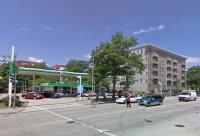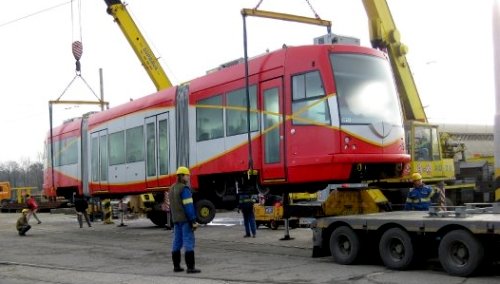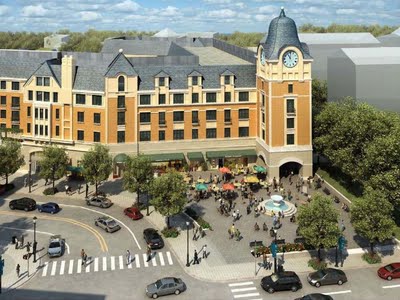|
Special Features





Image Libraries


|
|
Blog
|

14th and Euclid, NW. A perfect place for a Metro station. |
For years BeyondDC has been making the case that our region should be more open to transit modes other than Metrorail. Metro is great, but with its extremely high price tag and with over a hundred miles of it already in service, what our region needs most now is better network coverage. At this time, a billion dollars would be better spent on 10 new streetcar lines than one new suburban Metro extension, for example.
But that having been said, it’s still interesting to look at Metro’s missed opportunities. Considering its contemporaries, Metro is a shockingly well-planned system, but it obviously could have been better. So putting aside questions of maintenance, funding, operations, engineering, etc, and assuming the completion of the Silver Line, here are the top 10 remaining places we wish there were Metro stations. They generally fall into two categories: activity centers and dense walkable neighborhoods far from an existing station.
Number 10: Kalorama
Aka the Hinckley Hilton. Although you can get to this spot halfway between Dupont Circle and Woodley Park easily enough, the gap between those stations feels enormous. This is the sort of station that would make Metro more of an urban subway and less of a commuter operation.
Number 9: Cardozo
Same deal as Kalorama, except it’s more important at 14th and Euclid because of the escarpment between Clifton Street and Florida Avenue, and because the neighborhood isn’t as wealthy. There aren’t many places so near the regional core that a strip mall could have survived so long. It wouldn’t have if there were a Metro station nearby.
Number 8: Starburst
H Street will soon have a streetcar, lest the most isolated-from-Metro of the District’s neighborhoods would have to be higher on the list.
Number 7: Brightwood
The Georgia Avenue corridor is the city’s longest, and in some ways its most urban. A station at Brightwood would fill the long gap between Petworth and Silver Spring left by the Green Line’s sudden turn east.
Number 6: Langdon Park
There is a tendency to think of everything in the triangle between North Capitol Street, New York Avenue, and Eastern Avenue, NE as “Brookland” and call it a day. Actually, the Rhode Island Ave corridor is a lot like the Georgia Avenue corridor. A station at Rhode Island and 18th, NE would open up dozens of city blocks to the primary transit network, and drastically improve Rhode Island Ave itself.
Number 5: Old Town Alexandria
The only non-District location in the top 10, this one is kind of a no-brainer. Only the most dedicated pedestrians walk from King Street Metro, and that stupid fake trolley is just embarrassing, on top of being slow.
Number 4: Adams Morgan
One of the city’s biggest nightlife destinations as well as one of its most walkable neighborhoods. Adams Morgan is a natural. It might be even higher on the list if it weren’t already relatively easy to access from Woodley Park and Columbia Heights.
Number 3: Truxton / Bloomingdale
Too big, too dense, and too close to the core not to have a direct connection.
Number 2: Lincoln Park
The Orange/Blue tunnel serves the southern part of Capitol Hill very well, but leaves the central part uncovered. A station exactly at the midpoint of the Capitol, the Anacostia River, H Street, and the Southeast Freeway – that is, right at Lincoln park – would serve the entire greater Capitol Hill area. It would be the go-to station for at least 100 of the city’s most walkable blocks.
Number 1: Georgetown
Could number one on the list be anything else? Washingtonians have been lamenting the lack of a station in Georgetown for as long as I can remember, and for good reason. A Georgetown station would serve an area as large and walkable as Lincoln Park, and as much of a regional nightlife destination as Adams Morgan. It’s the perfect storm of transit want.
I still think that streetcars, BRT and improvements to commuter interurban rail would be a better investment at this time than expanding Metro, but if nothing else fun exercises like this can inform us about what gaps in the system need to be filled, via Metrorail or other modes.
Honorable Mentions: Historic Anacostia, Glover Park, Cathedral Heights, Logan Circle, BWI, Shirlington.
Cross-posted at Greater Greater Washington.
Average Rating: 5 out of 5 based on 175 user reviews.
November 30th, 2009 | Permalink
Tags: top10, transportation

It’s very unlikely there will be any new posts over the holiday weekend. Tweets are a possibility, however.
If you need a diversion in the mean time, quiz yourself. Can you name all 52 US metro areas with more than 1, 000, 000 population? Or for an easier one, can you name the 8 DC-area Metro stations with a shape in their name? Sporcle FTW.
Average Rating: 4.5 out of 5 based on 282 user reviews.
November 25th, 2009 | Permalink
Tags: fun, site

Here’s the study showing that user fees (the gas tax, tolls, etc) only cover 51% of highway costs.
Here’s Ryan Avent’s summary and response.
The next time somebody argues that we shouldn’t invest in transit or passenger rail because it has to be subsidized, ask them what they think of this.
Average Rating: 4.5 out of 5 based on 265 user reviews.
November 24th, 2009 | Permalink
Tags: transportation

Most readers of this blog are probably already aware that “Washington” and “District of Columbia” haven’t always been synonyms. Just in case, here’s how it works:
During the colonial period the farmers and plantation owners of Virginia and Maryland needed port cities to ship goods to/from Europe and to serve as regional markets. The most obvious place for a port was at the fall line of the Potomac River, the highest point upstream (and therefore most convenient to farmers) where ocean-going ships could travel. Small ports were founded at Alexandria in 1730 and Georgetown in 1745. The cities of Alexandria and Georgetown grew rapidly and were officially chartered in 1749 and 1751, respectively. They grew and prospered, so that by the 1800 census Alexandria was the 22nd largest city in the young United States, and Georgetown the 32nd. By comparison, the 22nd and 32nd largest metropolitan areas today are Pittsburgh and Columbus. For their day, Alexandria and Georgetown were big cities.
In 1790 Congress mandated that the new capital city be located along the Potomac. By 1791 the boundaries of the would-be District of Columbia were settled, to intentionally include the existing cities of Alexandria and Georgetown. L’Enfant began his famous work that same year. In 1800 the US government was moved to Washington, which began to grow in earnest. In 1801 the District of Columbia Organic Act was passed by Congress, officially creating the DC territory, which included two separate counties and three separate cities. Alexandria County was south of the Potomac River and included the City of Alexandria, as well as unincorporated rural land in what is now Arlington. Washington County was north of the river and included the City of Washington, the City of Georgetown, and surrounding unincorporated areas.
The two county / three city arrangement continued until 1846, when Alexandria County was retroceded to Virginia. For the next 25 years “Washington County” was synonymous with “District of Columbia”, but the cities of Washington and Georgetown remained separate, and all development in Anacostia or north of what is now Florida Avenue remained unincorporated. It was not until 1871 that Washington County and all its component cities was consolidated to form the unified City of Washington, DC. Since then, “DC” and “Washington” have been synonyms.
Of course it’s impossible to know for sure, but I like to imagine what the fall line of the Potomac would look like today had it not become the seat of government. Would the region have faded into the history books like Middleborough, MA (23rd biggest city in 1800, and it hasn’t grown much since), or would it have become a large, dynamic metropolitan area on its own terms? Given the importance and size of the Potomac River economy it seems safe to suggest that there would be some sort of dual-core “twin cities” metropolitan area here today, but just how big? Dallas / Fort Worth or Fredericksburg / Falmouth?
Average Rating: 4.9 out of 5 based on 244 user reviews.
November 23rd, 2009 | Permalink
Tags: history

Want to know where those hundreds of millions of dollars in cuts to Virginia’s transportation budget are coming from? The $400 million or so worth of them that are direct cuts to construction projects are listed here (pdf). Mostly the cuts are to smaller projects, with the largest single cut being about $40 million from a highway interchange project in Hampton Roads. The other $450 million in cuts out of the $850 million total cited by the Post include other categories, such as maintenance and administration.
You can see what’s still in the construction budget by visiting VDOT’s six year improvement program.
Average Rating: 4.4 out of 5 based on 163 user reviews.
November 19th, 2009 | Permalink
Tags: economy, government, transportation

The three streetcar vehicles that were produced for DDOT in 2007 and have been in storage in the Czech Republic since then are officially on the move and will be in DC by mid-December. No word on where they will reside once here or whether the public will have access, but regardless – they are on their way!
Isn’t this beautiful?

One of DC’s new streetcars being loaded to leave Europe for America.
For a larger version and three more pictures of the event,
go to DDOT’s Facebook page.
Photo courtesy DDOT.
Cross posted at Greater Greater Washington.
Average Rating: 4.6 out of 5 based on 289 user reviews.
November 17th, 2009 | Permalink
Tags: events, transportation

The bad news: UMD East Campus, a massive expansion of downtown College Park that would have been the largest new TOD along the Purple Line, is dead in the water. The developer pulled out, citing the recession. Ultimately the University still wants to develop that parcel as planned, but without a developer the future is uncertain.
The good news: Howard County is excited about a developer proposal for a TOD in Elkridge, at the Dorsey MARC station. While not exactly a new Ballston, the 1, 400 residential units and 1, 000, 000 square feet of commercial space proposed is respectable. The site is a little far from the MARC station, so layout and urban design will be particularly important. Unfortunately, a plan doesn’t appear to be available online.
Average Rating: 4.6 out of 5 based on 274 user reviews.
November 16th, 2009 | Permalink
Tags: development, economy

Remember the Brookland Small Area Plan that was so contentious? Since it passed in March plans have been in the works to actually implement portions of it. According to the Post, Abdo Development received preliminary approval from the DC Zoning Commission on Monday to move forward with a project totaling 825 residential units and 85, 000 square feet of retail. DCmud has a post up with several renderings of the project, including this one:

Soon to grace Michigan Avenue at Monroe Street.
Abdo has hired Torti Gallas to do the design, which is the same firm behind most of the new condo buildings in Columbia Heights.
This development is great news, and the architecture is solid. Go Brookland.
Average Rating: 5 out of 5 based on 251 user reviews.
November 12th, 2009 | Permalink
Tags: architecture, development

The Northern Virginia Streetcar Coalition is a grassroots community organization advocating for the creation of a regional streetcar network in Arlington, Alexandria and Fairfax. Essentially, their goal is to support development of an extensive streetcar plan in Virginia similar to the one DC recently publicized, and that BeyondDC has been promoting since 2008.
The group, which isn’t affiliated with any of the DOT or planning agencies in Virginia, is holding a kick-off meeting on Wednesday, November 18, from 7:00 to 9:00 pm. The meeting will be at the Alexandria campus of NOVA Community College and will feature a panel of speakers including Arlington County Board member / regional transit guru Chris Zimmerman.
More information about the meeting is available on Facebook.
Average Rating: 4.7 out of 5 based on 277 user reviews.
November 12th, 2009 | Permalink
Tags: events, transportation

A developer in Toronto will soon build a 42-story condo tower with zero – zero – parking spaces for private cars. They received approval for the tower in September over the objections of city zoning staff who, following the regulations enacted into law by the city’s zoning code, demanded a massive parking garage be included in the project. The developer says smaller units without bundled parking sell better, and that providing a parking space would increase the cost of each condo unit by $20, 000.
This is a perfect example of how government regulation subsidizes and supports car use. If the normal city law requiring parking had been followed the developer would have been forced to build more expensive condo units, with unnaturally easy car access. It would have been an anti-market double whammy, artificially decreasing the supply of needed affordable housing while increasing the number of people driving (since people are more likely to drive if you contrive to make it easier to do so). And of course, since those same laws are in effect all over the city, the result compounds itself across the metropolis and results in an entire city with more parking and more expensive condos than the market wants. Since virtually every city in Canada and the United States has such laws, our entire civilization is over-housed and over-parked.
Good on Toronto for taking a step to change things.
Average Rating: 4.6 out of 5 based on 173 user reviews.
November 10th, 2009 | Permalink
Tags: development, law

|
Media





Site
About BeyondDC
Archive 2003-06
Contact
Category Tags:
Partners
|

















